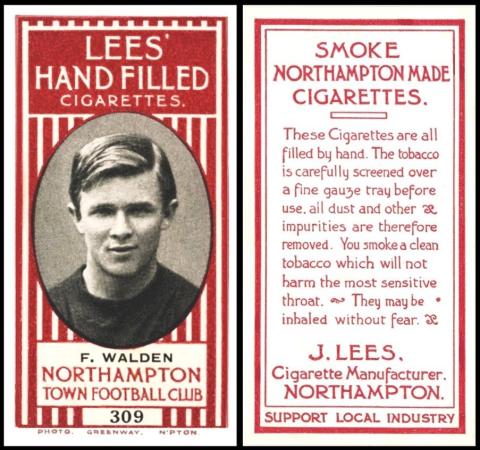
The clue here was not the team, Northampton Town, which was fairly easy to spot - instead it was their nickname, the Cobblers, which is the correct name for a shoemaker, and hopefully a good one who make shoes that fit our feet like gloves.
The connection between the shoe and Northampton is a long one, for it was already known as a centre of shoe and boot making in the seventeenth century. However it was the Industrial revolution that added the power in every way. Originally boots and shoes were made by home workers, paid by the piece - but once mechanisation came along it was much faster and cheaper to have them made in a factory setting. This also changed the landscape, for it was this industry which first came up with the idea of housing their workers in rows, all leading to the factory.
Northampton Town started off at the County Ground, in 1897, and they stayed there right until 1994, when they moved to their present ground - which is called Sixfields. You can read their full story at their own Club Website
Our player, Frederick Ingram "Fanny" Walden, he was born on March 1, 1888 in Wellingborough, Northamptonshire. He was known as "The Cobblers Midget", but was not so small really, 5 ft 2 ins. However he was an amazing player, able to weave his way through all defences, so good that he was bought by Tottenham Hotspur in 1912, for the amazing price of £1,700, and he stayed there until 1926. He also played football internationally, for England, twice, and cricket, for Northamptonshire.
And he appears on at least three cigarette cards :
W.D. & H.O. Wills "Famous Footballers" Scissors Brand (1914) 31/50 -
as F. Walden (Tottenham). This text is quite intriguing as it says that the nickname "...was designated by his admirers at Northampton, by reason of his resemblance to a little girl...". It adds that "He only stands 5 ft.2 1/2 ins., and weighs 9 stone 3 lbs." As for his sporting prowess this card adds more, saying he "...is a good swimmer, and a boxer of no mean ability " There are also anomalies, for it calls him "Fred Walden", the only card so far to do so, and it says he was born at "Wellington" not Wellingborough.
W.A. & A.C. Churchman "Footballers (1914) 15/50 -
as F. Walden - this shows him at Tottenham Hotspur but tells us he "played for Kettering before joining Northampton". The text also says "Although on the small side, "Happy Fanny", as he is generally known, has been the undoing of many strong defences".
F. & J. Smith "Football Club Records 1916-17’ (1918) –
as F. Walden, O.H.M.S. (Tottenham Hotspur) - the O.H.M.S. standing for On His Majesty`s Service, or in other words fighting in the First World War. And you can read a bit about this at FootballWW1/Walden
He also appears in the text on the reverse of Ogden`s and Hignett`s "A.F.C. NICKNAMES" where it closes rather oddly, with : "In those days they had several fine players, the most famous being Walden, the midget outside right".
Our Directory of British Issuers (RB.7, published in 1946) tells us that J. Lees were at Bridge Street, Northampton, and that they were a wholesale tobacconist and stationer. Intriguingly it then says they “sponsored one set of local interest, “Northampton Footballers” (1915).” Sponsored is an odd term, but they seem not to have had a brand, these cards just saying “Northampton Made Cigarettes”, and perhaps this was a combination effort between local growers, one of whom suggested issuing cards, which Lees agreed to pay for the production thereof.“ After all, at the bottom of the reverse it says, proudly, “Support Local Industry”, and the first line of text, “These Cigarettes are all filled by hand”, suggests local workers too. Our original World Tobacco Issues Index does try to ruin my idyllic, co-operative dream, by saying Lees were a “Cigarette Manufacturer” - but this is on the card, and it actually means they were the maker, at the root of the tree, and there maybe there was no space to list the branches.
It also tells us the cards were issued 1915, and catalogues them as :
NORTHAMPTON TOWN FOOTBALL CLUB. Sm. 67 x 35. Portrait in oval in black and white, surround in maroon. No`s 301/321 seen (?21).
This wording is repeated exactly in our updated World Tobacco Issues Index. However we do now know that the first “3” was a prefix, though not why, and that there are indeed twenty-one cards in the set.
Before we leave the card, look right down the bottom on the front and you will see a small line of type, “PHOTO GREENWAY, N`PTON”. This is Samuel H. Greenway, one of the largest of the area`s photographers, with studios at Northampton and Daventry. They also made photo postcards, and offered "outdoor photography" from the early 1900s.
